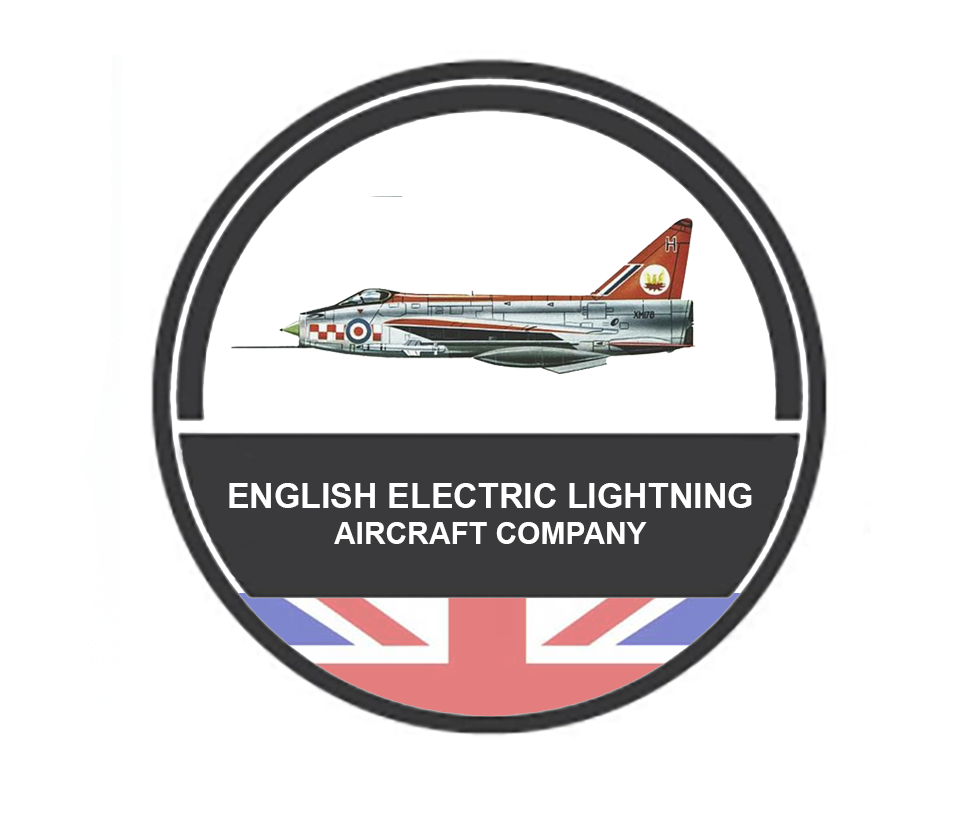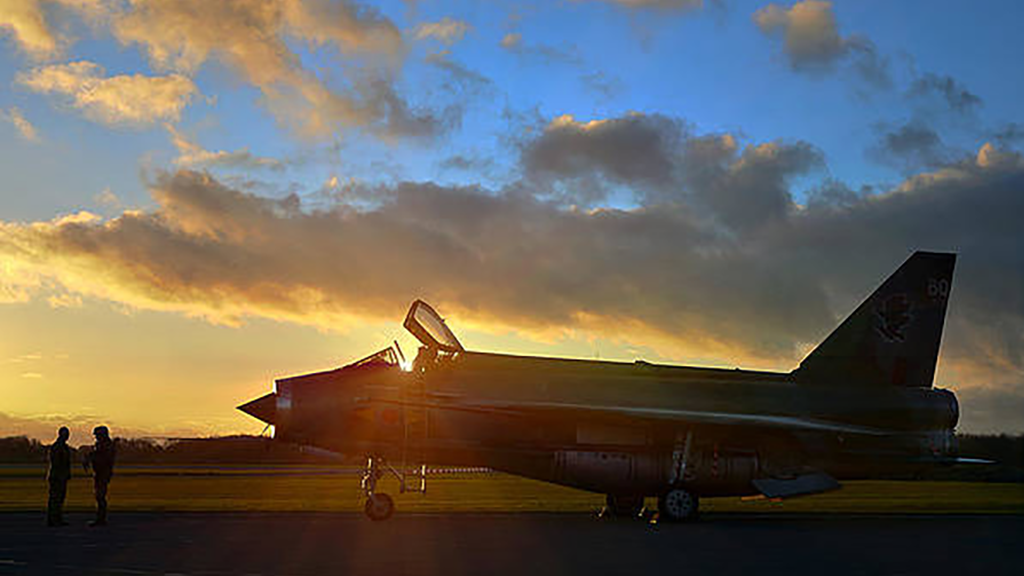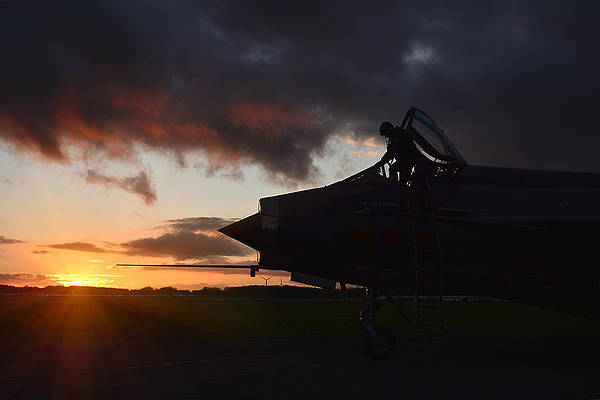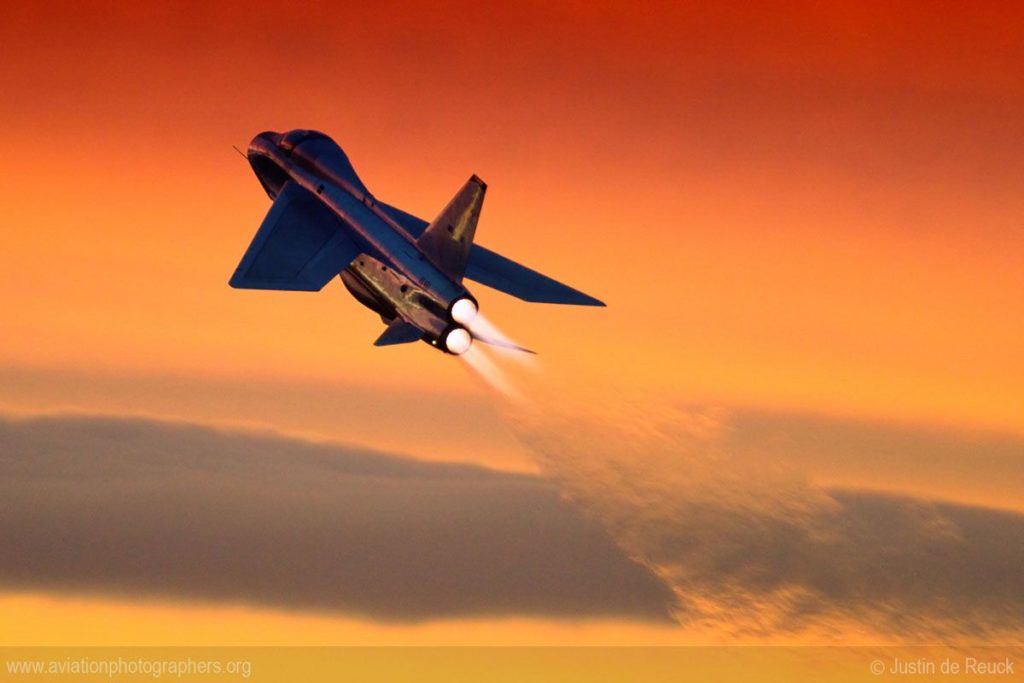ENGLISH
ELECTRIC
LIGHTNING
HERITAGE
The English Electric supersonic interceptor (WG760), piloted by Roland Beamont, first flew at Boscombe Down, Wiltshire as the English Electric P1 on 4th August 1954. Initial designs were led by WEW ‘Teddy’ Petter although the aircraft is mostly credited to his successor Freddie Page.
A unique feature of the design was its vertically staggered engine configuration of two Rolls-Royce Avon turbojets, housed within the fuselage. The aircraft was initially conceived as an interceptor, designed to defend airfields housing Britain’s V Force of bombers, comprised of the Avro Vulcan, Handley Page Victor and the Vickers Valiant. It was thought that during the Cold War of the 1960’s these could be vulnerable to attack from the air in any future nuclear conflict.
Petter’s initial design was for an aircraft capable of Mach 1.5 and he determined that as a consequence a conventional 40° swept wing would be required. A proposal was submitted November 1948, and after the project was provisionally accepted by English Electric, it was given the designation P.1 in January 1949.
On 29th March 1949, the Ministry of Supply granted their approval for work to begin on a more detailed design, as well as the creation of wind tunnel models and a full-size mock-up. The design developed at quite a pace and in the latter part of 1949, the target speed was broadened to Mach 2. This meant that in Petter’s opinion, the required wing sweep needed to be increased to 60° with the ailerons moved to the wingtips. Low-speed wind tunnel tests showed vortex issues would be generated by the wing, creating a large downwash on the tailplane. This was quickly resolved by lowering the height of the tailplane.
The project suffered a major blow however, when Petter suddenly resigned in December 1949 after his demands for greater autonomy for his Lightning Design Team were not met. Freddie Page took over as Design Team Leader for the English Electric P.1, for which the Ministry of Supply had issued Specification F23/49 and subsequently expanded the scope of ER103, to include fighter-level manoeuvring. On 1st April 1950, English Electric then received an official contract for two flying and one static airframe.
The aerodynamicists at the government led Royal Aircraft Establishment (RAE) were deeply sceptical of swept wing concepts and so Short Brothers in Belfast were contracted to produce the Short SB.5. Built between 1950 – 52, the Short SB.5 was to prove the design of both the wing and the tailplane, and to fully assess overall flight handling. It was effectively a low-speed highly unorthodox, adjustable wing research aircraft, designed so that different wing sweep angles could be tested by a single aircraft. After testing a range of wing and tail configurations, on 2nd December 1952 it was agreed that Petter’s 60-degree wing sweep specification was indeed the most effective.
The English Electric P.1 wing design, combined with 2 x Rolls-Royce Avon engines configured in a unique stack-staggered arrangement, produced an aircraft with a speed capability of Mach 2. Additionally, it also gave the aircraft an unrivalled rate of climb which was often described as being ‘a pilot sitting on two rockets’. It should be noted however that the initial flights of the P.1 utilised un-reheated Armstrong Siddeley Sapphire engines due to delays in the development program of the Avon engine.
The first three prototype aircraft were hand-built at the English Electric factory at Salmesbury, Lancashire from 1953 onwards.
Work started on a second group of prototypes, designated English Electric P1.B, and these represented a significant improvement, incorporating extensive alterations to the forward fuselage and the much-awaited reheated Rolls Royce Avon R24R engines. The P1.B aircraft (XA847, XA853 & XA856) also saw the introduction of the iconic and instantly recognisable conical inlet cone as well as variable nozzle reheat, provision for weapons systems that were integrated with the ADC and AI.23 radar. The three earlier prototypes meanwhile were updated and reclassified from P.1 to P1.A.
The two flying prototypes (WG760 & WG763) and the static aircraft (WG765) were fitted with the un-reheated Armstrong Siddeley Sapphire turbojets. This limited the internal fuselage space and meant that fuel capacity was relatively small, resulting in a limited endurance during testing. This also had a knock-on effect that the narrow tyres wore out much faster because of the greater number of take-off and landing phases. Visually, the prototypes looked similar to the production aircraft however, apart from rounded-triangular intakes, short fins and a reduced level of normal operational equipment.
In May 1954, one of the initial prototypes (WG760) was relocated to Boscombe Down for pre-flight ground taxi trials and it flew for the first time on the morning of 4th August 1954, piloted by Roland ‘Bee’ Beamont.
Not only were the initial flight tests a success, just a week later it officially achieved supersonic flight for the first time, exceeding the speed of sound during only its third flight. In fact, it was later discovered during the data analysis of its first flight some days later that it had already exceeded Mach 1 (1,225 km/h). However, these flights had proven the English Electric P.1 design to be viable although they were restricted to Mach 1.51 (1,850 km/h) due to directional stability limits.
In May 1956, the English Electric P.1B received the official name ‘Lightning’ said to have been derived to reflect the aircraft’s supersonic capabilities.
The second P1.B prototype (XA847) then made its first flight on 4th April 1957, again with Beamont taking the aircraft to a speed in excess of Mach 1. After a summer of proving and flight tests, he then ‘pushed the envelope further’ on 25th November 1957, exceeding Mach 2, becoming the first British aircraft to achieve such a speed.
During the early flight trials of the P.1B speeds in excess of 1,000 mph were achieved daily. Whilst the English Electric P.1B was potentially faster than the Fairey Delta FD2 (which broke the air speed record at 1,132 mph on 10th March 1956) it lacked the fuel capacity to provide the ‘one run in each direction at maximum speed’ in order to qualify for the record.
The first operational English Electric Lightning variant, designated Lightning F.1, was designed as an interceptor and to best perform this mission, emphasis was placed on rate-of-climb, acceleration, and speed, rather than range and so a radius of operation of 150 miles (240 km) from the V bomber airfields was the initial requirement. Aden guns and interchangeable weapon pack were developed alongside onboard radar for missile guidance, search, and range capability.The next two English Electric Lightning variants (the F.1A and F.2) contained only minor changes whilst the English Electric Lightning F.3 was a different story.
It had higher thrust Rolls-Royce Avon 301R engines, a larger more squared-off fin and strengthened inlet cone. This raised the service clearance from Mach 1.7 (2,083 km/h) to Mach 2.0 (2,450 km/h). Changes and deletions on the weapons front were also included and the English Electric Lightning F.3 was the highest performance variant at that point. However, additional performance resulted in higher fuel consumption which in turn reduced the range which proved an issue for some air forces around the world. Although the next variant, the English Electric Lightning F.6, was already in development, there was an urgent need to find an interim solution.
This was found in the English Electric Lightning F.3A which introduced 2 simple solutions. The first and most obvious was a new, non-jettisonable 610-imperial-gallon ventral fuel tank as well as a new, kinked, conically cambered wing leading edge. This second change accommodated a slightly larger leading edge fuel tank, raising the total usable internal fuel by 716 imperial gallons. This increased fuel only solved one of the major customer concerns as the lack of cannon armament was also thought to be a major deficiency as most pilots thought that cannons were most important to fire warning shots during any intercept mission.
Flying for the first time on 6th June 1965, the English Lightning F.6 was the ultimate variant for the RAF and was almost identical to the F.3A apart from its ability to be fitted with 2 x 260-imperial-gallon ferry tanks, mounted on pylons above the wings. In an emergency these tanks could be jettisoned. The modified ventral tank allowed for two ADEN cannons, mounted in the front. This did have a negative effect on the fuel capacity from 610 to 535 imperial gallons although this was accepted by pilots who announced that the English Electric Lightning F.6 was once again a ‘real fighter’ once more.
The final British Lightning was the F.2A, developed in 1966. Effectively, this was an F.2 upgraded with the cambered wing, the squared fin, and the same ventral tank as the Lightning F.6. It retained the A.I.23 Radar, Firestreak missile, nose cannon and the Avon 211R engines. Although the F.2A lacked the overall thrust of the later variants, it had a much larger range and was used to great effect in low-altitude interception over West Germany.
Often referred to as the ‘Export Lightning’ the English Electric F.53 Lightning was developed by BAC as a private venture. From the outset, this variant was designed to have a multi-role capability changing between interception, reconnaissance, and ground-attack duties. Based upon the airframe and avionics of the F6, it incorporated large ventral fuel tank, cambered wing, and over-wing pylon mountings for drop tanks. It boasted a capability to carry a large menu of weaponry as well as the almost essential defensive Aden Cannons.
A further development was the English Electric Lightning T.55 2-seater, equipped for combat duties. With a fuselage broadly similar to the T.5 variant, it also utilised the wings and large ventral tank from the F.6. Unfortunately, whilst retaining all of the English Electric Lightning’s exceptional climb rate and manoeuvrability, it also suffered the same difficulty of maintenance.
By 1963, the newly formed British Aircraft Corporation (which had subsumed English Electric) were working on a design for a two-seat Lightning development with a variable-geometry wing.
In addition to a variable-sweep wing (sweeping between 25 degrees and 60 degrees), the design featured an extended ventral pack, an enlarged dorsal fin fairing, an arrester hook, and a revised inward-retracting undercarriage. Initially conceived as a carrier-based aircraft, the ‘VG Lightning’ concept was also revised into a land-based interceptor, intended for RAF use. Various alternative engines were proposed, such as the newer Rolls-Royce Spey engine. With air inlets relocated to the sides of the fuselage, this would have seen the end of the famous Lighting nose cone.
The official ceiling of the BAC Lightning was a closely guarded secret although it is said to be in excess of 60,000 ft and it is well renowned for its exceptional rate of climb at 20,000 ft per minute.
Although never credited with an official ‘kill’ the English Electric / BAC Lightning did shoot down one aircraft when it was called upon to deal with a Hawker Harrier which unintentionally continued to head for the East German border after the pilot had ejected following apparent engine failure.
The BAC Lightning served in 16 variants within the Air Forces of Kuwait and Saudi Arabia as well as continuing in service with the RAF from 1959 until 1988, and some 337 aircraft were built in its 34-year history. Although proposed, the Sea Lightning FAW1 was never built.
Today, it remains one of the most loved and revered of British Fighter aircraft and represents an era of unrestricted noise and power. Although there are a number of preserved examples around the world, sadly there are no longer any English Electric Lightnings in the sky.
A unique feature of the design was its vertically staggered engine configuration of two Rolls-Royce Avon turbojets, housed within the fuselage. The aircraft was initially conceived as an interceptor, designed to defend airfields housing Britain’s V Force of bombers, comprised of the Avro Vulcan, Handley Page Victor and the Vickers Valiant. It was thought that during the Cold War of the 1960’s these could be vulnerable to attack from the air in any future nuclear conflict.
Petter’s initial design was for an aircraft capable of Mach 1.5 and he determined that as a consequence a conventional 40° swept wing would be required. A proposal was submitted November 1948, and after the project was provisionally accepted by English Electric, it was given the designation P.1 in January 1949.
On 29th March 1949, the Ministry of Supply granted their approval for work to begin on a more detailed design, as well as the creation of wind tunnel models and a full-size mock-up. The design developed at quite a pace and in the latter part of 1949, the target speed was broadened to Mach 2. This meant that in Petter’s opinion, the required wing sweep needed to be increased to 60° with the ailerons moved to the wingtips. Low-speed wind tunnel tests showed vortex issues would be generated by the wing, creating a large downwash on the tailplane. This was quickly resolved by lowering the height of the tailplane.
The project suffered a major blow however, when Petter suddenly resigned in December 1949 after his demands for greater autonomy for his Lightning Design Team were not met. Freddie Page took over as Design Team Leader for the English Electric P.1, for which the Ministry of Supply had issued Specification F23/49 and subsequently expanded the scope of ER103, to include fighter-level manoeuvring. On 1st April 1950, English Electric then received an official contract for two flying and one static airframe.
The aerodynamicists at the government led Royal Aircraft Establishment (RAE) were deeply sceptical of swept wing concepts and so Short Brothers in Belfast were contracted to produce the Short SB.5. Built between 1950 – 52, the Short SB.5 was to prove the design of both the wing and the tailplane, and to fully assess overall flight handling. It was effectively a low-speed highly unorthodox, adjustable wing research aircraft, designed so that different wing sweep angles could be tested by a single aircraft. After testing a range of wing and tail configurations, on 2nd December 1952 it was agreed that Petter’s 60-degree wing sweep specification was indeed the most effective.
The English Electric P.1 wing design, combined with 2 x Rolls-Royce Avon engines configured in a unique stack-staggered arrangement, produced an aircraft with a speed capability of Mach 2. Additionally, it also gave the aircraft an unrivalled rate of climb which was often described as being ‘a pilot sitting on two rockets’. It should be noted however that the initial flights of the P.1 utilised un-reheated Armstrong Siddeley Sapphire engines due to delays in the development program of the Avon engine.
The first three prototype aircraft were hand-built at the English Electric factory at Salmesbury, Lancashire from 1953 onwards.
Work started on a second group of prototypes, designated English Electric P1.B, and these represented a significant improvement, incorporating extensive alterations to the forward fuselage and the much-awaited reheated Rolls Royce Avon R24R engines. The P1.B aircraft (XA847, XA853 & XA856) also saw the introduction of the iconic and instantly recognisable conical inlet cone as well as variable nozzle reheat, provision for weapons systems that were integrated with the ADC and AI.23 radar. The three earlier prototypes meanwhile were updated and reclassified from P.1 to P1.A.
The two flying prototypes (WG760 & WG763) and the static aircraft (WG765) were fitted with the un-reheated Armstrong Siddeley Sapphire turbojets. This limited the internal fuselage space and meant that fuel capacity was relatively small, resulting in a limited endurance during testing. This also had a knock-on effect that the narrow tyres wore out much faster because of the greater number of take-off and landing phases. Visually, the prototypes looked similar to the production aircraft however, apart from rounded-triangular intakes, short fins and a reduced level of normal operational equipment.
In May 1954, one of the initial prototypes (WG760) was relocated to Boscombe Down for pre-flight ground taxi trials and it flew for the first time on the morning of 4th August 1954, piloted by Roland ‘Bee’ Beamont.
Not only were the initial flight tests a success, just a week later it officially achieved supersonic flight for the first time, exceeding the speed of sound during only its third flight. In fact, it was later discovered during the data analysis of its first flight some days later that it had already exceeded Mach 1 (1,225 km/h). However, these flights had proven the English Electric P.1 design to be viable although they were restricted to Mach 1.51 (1,850 km/h) due to directional stability limits.
In May 1956, the English Electric P.1B received the official name ‘Lightning’ said to have been derived to reflect the aircraft’s supersonic capabilities.
The second P1.B prototype (XA847) then made its first flight on 4th April 1957, again with Beamont taking the aircraft to a speed in excess of Mach 1. After a summer of proving and flight tests, he then ‘pushed the envelope further’ on 25th November 1957, exceeding Mach 2, becoming the first British aircraft to achieve such a speed.
During the early flight trials of the P.1B speeds in excess of 1,000 mph were achieved daily. Whilst the English Electric P.1B was potentially faster than the Fairey Delta FD2 (which broke the air speed record at 1,132 mph on 10th March 1956) it lacked the fuel capacity to provide the ‘one run in each direction at maximum speed’ in order to qualify for the record.
The first operational English Electric Lightning variant, designated Lightning F.1, was designed as an interceptor and to best perform this mission, emphasis was placed on rate-of-climb, acceleration, and speed, rather than range and so a radius of operation of 150 miles (240 km) from the V bomber airfields was the initial requirement. Aden guns and interchangeable weapon pack were developed alongside onboard radar for missile guidance, search, and range capability.The next two English Electric Lightning variants (the F.1A and F.2) contained only minor changes whilst the English Electric Lightning F.3 was a different story.
It had higher thrust Rolls-Royce Avon 301R engines, a larger more squared-off fin and strengthened inlet cone. This raised the service clearance from Mach 1.7 (2,083 km/h) to Mach 2.0 (2,450 km/h). Changes and deletions on the weapons front were also included and the English Electric Lightning F.3 was the highest performance variant at that point. However, additional performance resulted in higher fuel consumption which in turn reduced the range which proved an issue for some air forces around the world. Although the next variant, the English Electric Lightning F.6, was already in development, there was an urgent need to find an interim solution.
This was found in the English Electric Lightning F.3A which introduced 2 simple solutions. The first and most obvious was a new, non-jettisonable 610-imperial-gallon ventral fuel tank as well as a new, kinked, conically cambered wing leading edge. This second change accommodated a slightly larger leading edge fuel tank, raising the total usable internal fuel by 716 imperial gallons. This increased fuel only solved one of the major customer concerns as the lack of cannon armament was also thought to be a major deficiency as most pilots thought that cannons were most important to fire warning shots during any intercept mission.
Flying for the first time on 6th June 1965, the English Lightning F.6 was the ultimate variant for the RAF and was almost identical to the F.3A apart from its ability to be fitted with 2 x 260-imperial-gallon ferry tanks, mounted on pylons above the wings. In an emergency these tanks could be jettisoned. The modified ventral tank allowed for two ADEN cannons, mounted in the front. This did have a negative effect on the fuel capacity from 610 to 535 imperial gallons although this was accepted by pilots who announced that the English Electric Lightning F.6 was once again a ‘real fighter’ once more.
The final British Lightning was the F.2A, developed in 1966. Effectively, this was an F.2 upgraded with the cambered wing, the squared fin, and the same ventral tank as the Lightning F.6. It retained the A.I.23 Radar, Firestreak missile, nose cannon and the Avon 211R engines. Although the F.2A lacked the overall thrust of the later variants, it had a much larger range and was used to great effect in low-altitude interception over West Germany.
Often referred to as the ‘Export Lightning’ the English Electric F.53 Lightning was developed by BAC as a private venture. From the outset, this variant was designed to have a multi-role capability changing between interception, reconnaissance, and ground-attack duties. Based upon the airframe and avionics of the F6, it incorporated large ventral fuel tank, cambered wing, and over-wing pylon mountings for drop tanks. It boasted a capability to carry a large menu of weaponry as well as the almost essential defensive Aden Cannons.
A further development was the English Electric Lightning T.55 2-seater, equipped for combat duties. With a fuselage broadly similar to the T.5 variant, it also utilised the wings and large ventral tank from the F.6. Unfortunately, whilst retaining all of the English Electric Lightning’s exceptional climb rate and manoeuvrability, it also suffered the same difficulty of maintenance.
By 1963, the newly formed British Aircraft Corporation (which had subsumed English Electric) were working on a design for a two-seat Lightning development with a variable-geometry wing.
In addition to a variable-sweep wing (sweeping between 25 degrees and 60 degrees), the design featured an extended ventral pack, an enlarged dorsal fin fairing, an arrester hook, and a revised inward-retracting undercarriage. Initially conceived as a carrier-based aircraft, the ‘VG Lightning’ concept was also revised into a land-based interceptor, intended for RAF use. Various alternative engines were proposed, such as the newer Rolls-Royce Spey engine. With air inlets relocated to the sides of the fuselage, this would have seen the end of the famous Lighting nose cone.
The official ceiling of the BAC Lightning was a closely guarded secret although it is said to be in excess of 60,000 ft and it is well renowned for its exceptional rate of climb at 20,000 ft per minute.
Although never credited with an official ‘kill’ the English Electric / BAC Lightning did shoot down one aircraft when it was called upon to deal with a Hawker Harrier which unintentionally continued to head for the East German border after the pilot had ejected following apparent engine failure.
The BAC Lightning served in 16 variants within the Air Forces of Kuwait and Saudi Arabia as well as continuing in service with the RAF from 1959 until 1988, and some 337 aircraft were built in its 34-year history. Although proposed, the Sea Lightning FAW1 was never built.
Today, it remains one of the most loved and revered of British Fighter aircraft and represents an era of unrestricted noise and power. Although there are a number of preserved examples around the world, sadly there are no longer any English Electric Lightnings in the sky.




OUR BRAND
We own the Trade Mark for ENGLISH ELECTRIC LIGHTNING registered with the Intellectual Property Office (IPO) under category 25 for all clothing, Footwear and Headwear.
For Licencing Opportunities contact us.